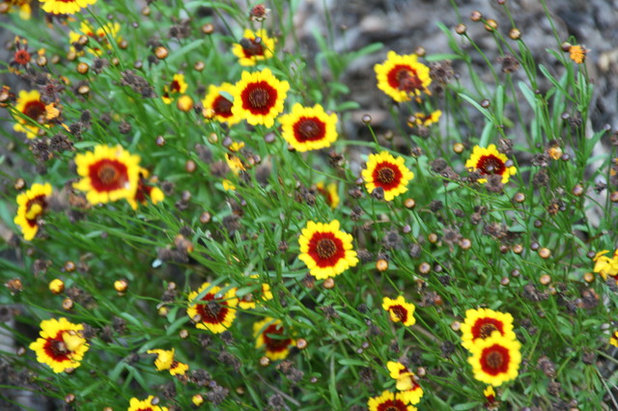One of the very first perennials I purchased for my urban country garden over two decades ago was a
coreopsis
— Coreopsis verticillata 'Moonbeam'. A garden later, one that has seen drastic changes as I defined my gardening style, still has 'Moonbeam' growing along the borders. Fall and spring are prime planting times.
Since I first became interested in coreopsis, this wildlife-attracting native has experienced many enhancements. It's an exciting time for gardeners enamored with this all-American genus. As I write this, I have two plant tags in my back pocket from coreopsis plants added to my garden this morning —
Coreopsis 'Cosmic Eye' and
Coreopsis 'Creme Caramel'. They will have a trial in my Raleigh, North Carolina, garden before their performance is reported.
Daisy-like flowers, typically in a classic yellow, best describe the species. However, recently there was a great shift in horticulture as coreopsis donned a new color — red.
Coreopsis ‘Redshift’
is an introduction by Darrell Prodst. Older cultivars tended to have cream, yellow or orange flowers. Lucky for lovers of rich, hot colors, the color break led to a red. Redshift was so named from this shifting, or break, in colors.

Gardening with Confidence®
Coreopsis' common name is tickseed, but don't let this unfortunate name scare you away. It
was given that name based on the look of the seed, not the beauty of the flower.
Coreopsis
was named from the Greek words
"koris," meaning “flea” (bedbug), and
"opsis,"
meaning “resembling.”
In coreopsis, the case that holds the seed (the achene) resembles a flea.
Botanical name: Coreopsis ‘Redshift’
Common names: Tickseed, Redshift
USDA zones: 4a to 8b (find your zone)
Water requirement: Minimal once established; drought tolerant
Light requirement: Full sun
Mature size: 2 to 3 feet tall and wide
Benefits and tolerances: Pest and disease tolerant; attracts wildlife; native cultivar; suitable for xeriscaping
Seasonal interest: Blooms all summer long
When to plant: Fall or spring

Gardening with Confidence®
Distinguishing traits. Blooms are an attractive yellow with a splash of red. I find there to be variations in the amount of red each year as the plant returns. I welcome the surprise.

Gardening with Confidence®
How to use it. Coreopsis ‘Redshift’ works well at the front edge of a garden bed. Redshift likes to splay, so it also works well in the interior of a garden bed, where it appears like a skirt on other perennials.
The added red offers a richness to summer and fall combinations. Combining Redshift with a native switchgrass that has red accents, such as
Panicum virgatum 'Shenandoah', pairs two relaxed styles for a bold statement.
Redshift massed as a ground cover will mimic the garden's design. If the bed has a very formal nature, Redshift will take on a formal flair. If planted as at the hem of country flowers and shrubs, it will take on a free-form naturalistic style.
A trick I've found using this plant in design: The more red I pair it with, the more the red of the coreopsis pops. And I'm all about pop!

Gardening with Confidence®
Redshift grows with great success in my garden. I grow several varieties of coreopsis, but the red lured me in, compelling me to add just one more. The red against yellow continues to elicit admiration of this native cultivar, and because it will bloom from early summer well into the fall, I can enjoy it for a full four months.
Redshift is also frequently visited by butterflies, adding even more color to gardens. It also makes a great cut flower for indoors.

Gardening with Confidence®
Planting notes. Even though the spread is about 2 feet, I like to place plants closer together so as they splay, the flowers of one plant will hide the crown of another.
• Plant in spring or fall, spacing plants 1 foot apart.
• Dig a hole twice the diameter of the nursery pot.
• Carefully remove the plant from its container and place it in the hole so the top of the root ball is level with the soil surface.
• Carefully backfill the native soil around the root ball.
• Gently firm the soil; water thoroughly.
• Apply a 2-inch layer of mulch to retain moisture and moderate soil temperature, and for weed control.
More yellow flowers for the home garden





